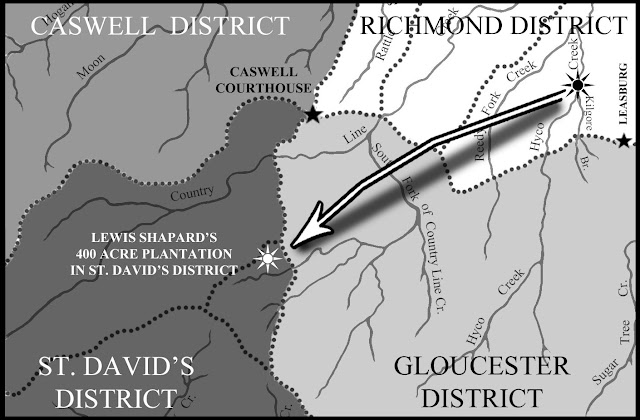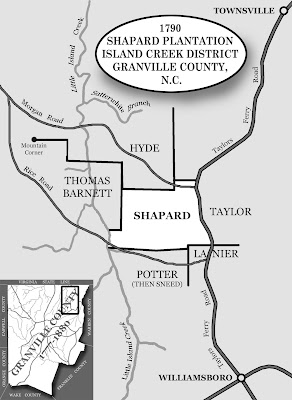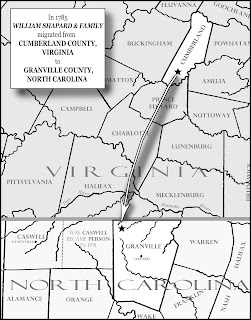Chapter 6
BACK TO ST. DAVID DISTRICT
1798-1800
A year
before the Shapards moved to their new plantation, Lewis sent ahead his slaves,
under the guidance of his brother Booker and brother-in-law Anderson Williams,
to plant the crops and build or repair the necessary quarters, out-buildings,
fences, etc. Thus, when Lewis and his family arrived in the summer of 1798, their
plantation was already in full operation. The 400 acre property resided within
the boundaries of St. David’s District, yet, was on the border of the
Gloucester District. It was located about four miles to the southeast of
Caswell Courthouse (Yanceyville). Neighbors included Joseph Chandler to east,
William Sawyer to the north, Alexander Kerr to west, and Richard Estes to the
south. The property was relatively flat, with its highest elevation to the
north. The southern end of the estate, being its lowest elevation, was
intersected the Dry Fork Branch of the South Fork of Country Line Creek (known
today as Penson Creek). The western and northeastern edges of the property fell
into heavily wooded creek beds, making those areas impractical for agriculture,
yet beneficial for wood supply and hunting. A publicly used path, which
eventually became Graves Mill Road, ran through the northern edge of the
property. Branching off from this road was a private path that meandered through
the crop fields ending at the Shapard’s plantation house positioned at the southern
end of the property just north of the creek. It is known that natural springs
supplied drinking water on the plantations to the east and west of Lewis
Shapard’s land. There is evidence that the Shapard plantation also had the benefit
of a fresh water spring and that the main house was positioned next to this
source of this water. The Shapard family would spend the next fifteen years making
this plantation their home.
In October of 1798, Lewis
Shapard and other prominent landowners were appointed by the Justices of the
County Court to consider blazing a new road through St. David’s District
leading to the courthouse. It was decided that the road should begin as a fork
off of the Hillsborough Road at the Brooks’ plantation (where James Shapard and
his wife Frances and widowed mother-in-law Anne Brooks lived) and end at Caswell
Courthouse near John Graves’ mill. In April of 1799, the court commissioned a
select group of landowners to fulfill the task of determining the actual course
of the road through the district, namely: Lewis Shapard, Thomas Johnston,
Bartlett Estes, Joseph Chandler, Thomas Kimbrough, Alexander Murphy, Robert
Martin, Richard Martin, Barzilla Graves, Graves Howard, Richard Cochran, Joseph
Bush, John Graves, Jr., John Graves, Sr., James Williamson, Mr. Johnston, John
Henslee, John Barker, David Barker, John Kerr, John Payne, Francis Smith,
Harvey Willis, Humphrey Roberts, Thomas Slade and William Slade.
By October of 1799, the
new road, known as Graves Mill Road, had been constructed and was ordered to be
maintained by Lewis Shapard, James Shapard, Anderson Williams, widow Brooks
hands, Joseph Chandler, John Pinson, Maeajah Estes, Bartlett Estes, Thomas
Johnston, Nathaniel Rice, widow Pyrants hands, Robert Thompson and William Slade.
Over the years, Graves Mill Road provided tremendous benefit and convenience to
the Shapard family, due to the fact that it passed through the northern edge of
their property. This road still exists today, being Marshal Graves Road then up
Badgett Sisters Parkway to the courthouse.
After his move to St.
David’s District, Lewis traveled often to the Caswell Courthouse tending to
business. He was still settling the estate of the late Michael Nicholson and
had to periodically report his progress to the justices. The court periodically
appointed commissioners to audit and settle his reported amounts, to ensure
that he was fulfilling his legal responsibility as administrator of the estate,
as well as, faithfully tending to his guardianship of the three Nicholson
orphans.
In July of 1798, Lewis
served as a jury member for a few trials at the Caswell Courthouse. Up to this
point in his life, Lewis had attended court always as a spectator or juryman; however,
at the next session of court in October of 1798, Lewis faced his first lawsuit as
a defendant. Lewis was sued for a delinquent debt by Mr. Jesse Carter in the
amount of £42.5.2, of which he was found guilty. Jesse Carter was a wealthy
storeowner of Caswell County and one of the first to purchase land around the new
courthouse in the 1790s. In 1801, he rose to political prominence after he was
elected as a Caswell County Justice. In 1802, he became one of the initial
trustees of the Caswell Academy, being the first school for classical education
established near Caswell Courthouse. Mr. Carter married Nancy Payne in 1793 and
then married her sister Elizabeth Payne in 1804. Despite the similarity, it
does not appear that these Paynes had any relation to the line of Martha (Paine)
Shapard.
Only six months later, at
the April 1799 session of the County Court, Lewis again found himself involved
in a lawsuit, after Thomas Robinson charged him with trespassing and assessed
his damages at £100. During this era, the legal meaning of ‘trespass’ was basically
‘any wrongful act that caused injury or financial loss,’ most often being the
result of debt, theft or damage to property. It appears that the ‘trespass’ was
the result of a lien dating back to 1797. The ‘lien’ was granted against a specific
item of Lewis’ property, as collateral, to ensure future payment by Lewis to Mr.
Robinson. It appears that over the course of the agreed upon three-year term of
the lien, Lewis had not satisfied or settled his financial obligation. The case
was settled in July, the jury finding against Lewis in the amount of £12 plus
court costs. Caswell County records are sparse with information revealing the
identity of Thomas Robinson; however, it appears that, in 1800, he resided the
Richmond District on 400 acres. Only a few months after the above lawsuit was
settled he died, leaving James Robinson to care for his orphans and Solomon
Graves as the administrator of his estate.
Interestingly, at nearly the
same time Lewis had been sued by Thomas Robinson for trespass in the amount of
£100, Lewis Shapard for the first time in his life became a plaintiff, when he
filed a lawsuit of trespass for £100 against Richard Johnson. Records indicate
that Mr. Johnson lived in the Richmond District on the Hyco River. On April 29,
1800, Lewis went to the Caswell County courthouse for the trial. The jury heard
the case, deliberated and returned a verdict in favor of Lewis Shapard in the
amount of £3.1.1 ½.
On
November 24, 1799, a baby girl named Sophia was born to Lewis and Martha Shapard.
Mrs. Shapard may have named her in honor of her sister Sophia Paine who was
born on August 6, 1781 and died as an infant on August 25, 1782. Only a few
months after Sophia Shapard’s birth, a census was taken for Caswell County for
the year 1800, recording the members of the Shapard household: Lewis Shapard was
a white male between the age of 26-45, Martha (Paine) Shapard was a white
female between the age of 26-45, William Shapard was a white male under 10
years old, four white females under the age of 10 (Sophia Shapard, Sallie
Nicholson, Polly Nicholson and Elizabeth Nicholson). The family was also listed
as having 8 slaves, two of which were under the age of sixteen. Finally, the
census recorded, as a resident of the house, Lewis’ younger brother Booker Shapard
as a white male between 16 – 26 years old.
Although
Booker lived at and was employed on his brother’s plantation, he was still
responsible for his bills, except for food and rent. Lewis often allowed Booker
the use of the products of the plantation for which Booker would reimburse him
when able. These products were mostly in the form of corn and fodder for his
horse, and leather for new shoes. For a fee, Booker would periodically utilize
Lewis’ slaves for needed services. These services included making his shoes and
washing and mending his clothes. Like Lewis, Booker was a very fashionable
young man for his era. He wore expensive stockings and clothing made from fine
store-bought fabric, as opposed to the more common homespun cloth. Most of his
fabrics and supplies were purchased from stores around the Caswell Courthouse
area, such as John Graves & Sons; however, he also made purchases with
local merchants such as Nathan Williams and Anderson Williams. To fabricate his
wardrobe, Booker obtained the talents of Rhoda and Zeba Bush, who lived near
Caswell Courthouse, as his personal tailor. His waistcoats were adorned with
gold gilt buttons and he carried silk handkerchiefs. He often acquired new
shoes, when his old ones wore down or as fashions changed.
In
1800, Booker would have been 24 to 25 years old; and, as is often the path of
many young men who find themselves with independence and financial means, the
allure of vices prevails over discernment. After moving to Caswell County, Booker
frequented the popular ordinaries (taverns) around Caswell Courthouse to
socialize, gamble and drink. Records show that he was a regular customer at the
tavern of John Graves, Sr., and indulged in brandy, whiskey and wine. In
addition, Booker carried a snuff box that held finely ground tobacco. The
tobacco was inhaled up the nose for the nicotine effect as opposed to smoking.
Snuff tobacco was infused with flavors to make it more palatable.
Although
Booker enjoyed socializing and entertainment, he also worked hard. Like his
brothers, Booker had training in carpentry. In particular, he may have been a
house joiner, whereby, he carefully fitted floorboards together and hand fabricated
the mouldings and trim work for the home’s interior. Booker’s toolbox consisted
of a broad axe, handsaw, hammer and three gimlets (hand drills). He also owned
two bench planes which were used to smooth and flatten wood. To further carve,
shape and refine the wood, he owned three moulding planes and a gouge chisel. Booker’s
skills as a carpenter were tremendously beneficial in the development of Lewis
Shapard’s plantation. In addition, Booker supplemented his income by also
offering his services to the public.
When
the January 1800 session of County Court for Caswell County commenced, Lewis
Shapard was in attendance. On the 27th of January he had a summons
issued by the court for Joshua Hudson for the payment of a £50 debt. Mr. Hudson
originally owed the money to William Smith, however, Mr. Smith assigned his
rights to the money as a payment to Lewis Shapard. The trial was set for the
forth Monday of April, yet, it appears that Lewis received his payment before
this date as the case vanished from the dockets.
While
at the courthouse on January 29, Lewis served as a jury member for a trial
involving The State vs. Robert Kimbrough, finding the defendant guilty and
fining him £5. In addition, while there, Lewis became a witness to the bastardy
bond between William Fitch (1780-1845) and Sally Bateman. During this era in North
Carolina, when a single woman birthed a child out of wedlock a warrant was
issued for the woman to appear in court. Under oath she was asked to name the
child's father. The father was then served a warrant and required to post bond
to support the child, so the child would not be a financial burden on the state.
The court would collect a judgment amount from the father, often borrowing the
funds from his bondsmen as security. Sometimes the woman risked incarceration
by refusing to name, the father; however, she, her father or some other
interested party could post the bond to prevent her from going to jail.
In
April of 1800, Lewis was again at the courthouse tending to a variety of legal
issues. On April 28, he served as a juryman during the trial of Joseph Speed
vs. James B. Davis. On April 29, Lewis was a defendant in his case with Thomas
Robinson over a delinquent lien. That same day he was also a plaintiff in his
trespass case with Richard Johnson. The following day, Lewis served as a member
of the jury on an interesting case between Lucy Smith and Sarah Smith. The
lawsuit records show that Lucy Smith was a negro and former slave of the Smith
family. At some point she was freed, perhaps through the Last Will &
Testament of her master, or she purchased her freedom. Needless to say, this
was a rare position for a woman of her race during this era. Even more
interesting was that she was literate, at least to the extent that she could
spell her name. Sometime prior to April of 1800, Lucy’s freedom was called into
question by Sarah Smith (possibly the daughter of her former master), who
claimed to be her rightful master. Treated as a runaway slave, Lucy was
physically assaulted during her “capture” and imprisoned. Lucy filed a writ
against Sarah Smith for trespass, assault & battery and false imprisonment,
assessing her damages at £100. During the trial the facts were presented to the
jury, and Lewis Shapard, et al., found Lucy to be a free woman and not the
slave of the defendant. The ruling illustrates that, despite the fact that the
jury was made up of slaveholders, they still respected the legal path to
freedom and ensured that right was preserved when earned. That being said, they
assessed her damages at one penny and court costs, which was a paltry restitution,
yet, typical settlement for negros by the judicial system of that era. Though a
free negro, poverty was used as a means to keep Lucy insignificant, limited and
within lower class society.
On
May 6, 1800, Lewis Shapard sold one of his slaves to James Cochran of Person
County, North Carolina. The slave was named Sancoe and was sold for £100. As
part of the sale, Lewis guaranteed the slave to be in good health, as well as,
the title for the slave to be free and clear of any other claims against it. To
conclude the transaction, a bill of sale was issued to Mr. Cochran by Lewis Shapard,
which was witnessed by Nathan Williams and Solomon Debow.
When
the July 1800 session of the County Court commenced, Lewis once again made his
way to Caswell Courthouse to address his legal issues. On July 28, 1800, a
summons was issued for Admiral White and Elyah Brown after Lewis obtained a
writ against them for an unpaid debt of £46. The debt was originally owed to
Richard Simpson; however, Mr. Simpson transferred the rights to the debt to
Lewis Shapard as a form of payment. From all accounts, Mr. White and Mr. Brown
settled the debt due Lewis Shapard prior to the trial date set for October,
1800. Lewis attended court as a juryman on July 29th for the case
between Nathan Sanders vs. William Rainey. The following day on July 30th,
he served on the jury for the trial of John Wilson vs. Richard Hill, executor
of Adam Parrott. That same day, he was a defendant in his own case with Thomas
Robinson, whereby, the jury found against Lewis in the amount of £12 and court
costs.

















